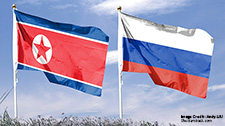The Case for Multilateralism: The Korean Peninsula in a Regional Context

Niklas Swanström
Series on Peacebuilding on the Korean Peninsula
This essay is part of an ongoing series by ISDP’s Korea Center to provide different perspectives on peacebuilding on the Korean Peninsula. In so doing, it recognizes that peacebuilding is a long-term process and involves different dimensions, from the diplomatic and military to economic and societal.
The Center would like to acknowledge that this publication was generously supported by the Korea Foundation.
Introduction
The Korean Peninsula remains an enduring conflict hotspot and security challenge. Since the end of the Korean War in 1953, efforts to build a sustainable peace have been thwarted amidst a long history of tension, aggression, and broken promises; this despite periods of temporarily improved relations and détente. Conflict resolution impulses have been further hampered by the complexities of geostrategic tensions and power rivalry in the wider Northeast Asian region amidst the enduring absence of any formal regional security structure.
With the exception of the ultimately failed Six-Party Talks (2003-09), the main focus of nuclear-related negotiations and agreements have been bilateral in nature, notably the 1994 Agreed Framework and the short-lived so-called 2012 Leap Day Deal between North Korea and the United States. However, breakthroughs have often failed to survive political transitions, geopolitical shifts, and the challenges of implementation.
This is not least true today when the promising bilateral contacts between President Trump and Chairman Kim, as well as the leaders of the two Koreas, initiated in 2018, have not been sustained and negotiations have stalemated. This points, in part, to the fragility of relying on bilateral diplomacy alone.
Accordingly, the points of departure in this essay are the regional security dynamics in Northeast Asia, the need to see the Korean Peninsula in a regional context, and why this necessitates multilateral frameworks and regional security initiatives to complement bilateral exchanges. It then reviews previous attempts to establish such structures, what they achieved, but also what limitations and challenges they faced. Finally, some lessons and principles are put forward on how future frameworks may be adopted.
Regional Security Dynamics
The region of Northeast Asia, here defined as Russia, China, Japan, North and South Korea, as well as the U.S. due to its strategic interests in the region, remains a security hotspot. Conflict dynamics include unresolved territorial and maritime disputes, historical enmities combined with nationalism and militarism, as well as geopolitical competition between the United States and China; and to a lesser extent Russia.
Despite the relatively positive economic cooperation and interdependence between regional states (excepting North Korea), this has not translated into overarching political and security cooperation. This is what has come to be referred to as the so-called “Asian Paradox.” Instead, security has been maintained through military deterrence and bilateral security alliances rather than through collective security arrangements, which remain undeveloped. While a decades-long feature of the politico-security landscape in Northeast Asia, it is presently in flux.
North Korea’s de facto nuclear weapons status has long-term implications and increases the calls in South Korea and Japan to also acquire their own nuclear weapons.4 Thus there is the very real potential of a nuclear arms race developing in the region if efforts for North Korea’s denuclearization do not succeed. Moreover, the abrogation of the Intermediate Nuclear Forces treaty (INF) between the United States and Russia could also exacerbate the situation if the U.S. decides to deploy intermediate-range ballistic missiles in the region in response to China and North Korea.
The rise of an increasingly economically and militarily assertive China also poses security implications for its worried neighbors. Increasing militarization amidst a conventional arms race between countries does not bode well for multilateral security cooperation and reducing threat perceptions.
The trade war and growing U.S.-China geostrategic competition means that Japan and South Korea face the dilemma of balancing relations with both powers while being pressured to side with their U.S. ally. Yet at the same time, under an erratic Trump administration in the White House, doubts have grown over U.S. alliance commitments to South Korea and Japan’s security.
Great power competition, furthermore, lessens the incentives for cooperation between China and the U.S. on Korean Peninsula issues, whereby the Peninsula instead turns into a theater for strategic confrontation. North Korea is adept at exploiting the gaps between the parties to its own advantage, thus reducing the pressure on it to denuclearize.
At the same time, the past decade has seen an increasing appreciation for the interrelated nature of the region’s economic, energy, security, climate, and environmental challenges. Shared challenges can be recast as shared opportunities which necessitate platforms for dialogue, cooperation, and integration at the regional level.
While these trends and dynamics may spur, and necessitate, constructive initiatives to create a new security architecture, they may also dangerously destabilize the region, raising the prospect of increased competition and conflict. Accordingly, the security situation on the Korean Peninsula is both influenced by wider regional dynamics as well as influences in the regional security environment. Peace and security on the Korean Peninsula cannot be considered outside of the wider Northeast Asian, and indeed, global context.
Beyond Bilateralism
In the absence of a relevant multilateral framework, the most recent phase of negotiations on the Korean Peninsula since 2018 has been characterized by bilateral summit-driven diplomacy between the different actors. This has included summits between the United States and North Korea, South and North Korea, China and North Korea, as well as North Korea and Russia. Japanese premier Shinzo Abe is presently the only regional leader to have not met with Kim Jong Un. These summits produced positive outcomes in the form of the Singapore Statement between the U.S. and North Korea in June 2018 as well as the two inter-Korean agreements, leading to an overall reduction in tensions.
These accomplishments, however, do not guarantee any lasting stability as relations are currently “stuck” in a bilateral structure that risks stalemating between uncompromising demands and personal agendas. The high stakes of bilateral summits were exposed at the second Hanoi Summit between President Trump and Chairman Kim in February 2019. Failure to find agreement and the consequent loss of face for both leaders has led to a stall in negotiations and a recalibration of negotiation strategies based on inflexible demands.
Bilateral talks between the U.S. and North Korea are essential for addressing nuclear and security concerns on the Korean Peninsula. Inter-Korean relations are also important for addressing these issues as well as promoting reconciliation. However, any sustainable peace and denuclearization process needs to encompass a broader range of stakeholders and regional issues.
A formal end to the Korean War through the signing of a peace treaty would require at a minimum the participation of the United States, China, and North Korea as original signatories of the Armistice Agreement, as well as arguably South Korea. Any such treaty would furthermore potentially entail significant modifications in the posture and purpose of the U.S. security alliance with South Korea, such as a reduction in U.S. military personnel, removing strategic assets away from the Peninsula, or reconfiguring military exercises.
All regional actors have a stake in North Korea’s denuclearization as well as the status of its other weapons of mass destruction and conventional missile capabilities. The consequences of a failure, or indeed success, in securing the denuclearization of North Korea, are thus very much of regional and even international importance.
The lifting of sanctions on North Korea, furthermore, and the provision of humanitarian and economic aid, requires consensus between China, Russia, and the U.S. as three of the five permanent members of the UN Security Council. While China and Russia have pushed for an easing of sanctions, the United States remains opposed in the absence of concrete denuclearization measures; this also impacts South Korea’s ability to carry out inter-Korean projects. The spectrum of issues involved will therefore require multilateral agreements and coordination if they are to be sustainably implemented.
Spoiler problems could also be endemic if strictly bilateral negotiations continue to be the driving mechanism. China, South Korea, Russia, and Japan all have interests in the process and will not sit idly by waiting for decisions which directly concern their future. For example, an agreement between the U.S. and North Korea on dismantling its ICBM program would cause considerable disquiet in South Korea and Japan if the threat from shorter and intermediate-range missiles was also not addressed. Incorporating the interests of a broader group of actors will thus be essential to prevent competing agendas and interests from undermining long-term security.
What is more, even if they are quicker and more adaptive as they depend on individual leaders, bilateral negotiation formats can be, and often are, more fragile than multilateral frameworks. The former may overly rely on interpersonal relationships between leaders, which in turn are vulnerable to changing governments, breakdowns of trust, and competing interests and priorities. Furthermore, bilateral processes are more likely to be driven by often short-term unilateral agendas, which may quickly stall should the sides fail to find agreement.
While all political processes are driven by political interests and unilateral agendas, these may become more “diluted” in a multilateral setting. These are also more likely to endure through setbacks or bilateral disputes. Where bilateral talks falter and there is a failure to achieve compromise or consensus, multilateral frameworks may prove a more sustainable format for maintaining dialogue on contentious issues and/or inviting mediation by other actors. On the other hand, multilateral frameworks may prove less adaptive and introduce more “baggage” in terms of conflicting agendas and multiplicity of issues to the detriment of finding agreements.
In the short term at least, it is unrealistic to expect that a multilateral framework will replace the primacy on bilateral talks. However, this is not to say that the two approaches are mutually exclusive: multilateral mechanisms need to work in parallel with bilateral meetings to complement each other.
In sum, the situation on the Korean Peninsula demonstrates that while improvements in bilateral relations provide a good point of departure and impetus, over the long term such arrangements are hard pressed to sustain and diversify the security dividend. Divergent interests, changes in political goals and administrations, as well as rising tensions between China and the U.S. will destabilize bilateral exchanges, making regional structures more necessary for maintaining long-term stability. A multilateral framework, therefore, would give each actor a voice and stake in shaping the outcome of a peace/denuclearization process that has implications for the Northeast Asian region as a whole.
Assessing Previous Multilateral Initiatives
As previously observed, Northeast Asia remains deprived of a formal region-wide security organization. This is not to say that there have not been efforts to promote multilateral security cooperation and dialogue in the region.
Initiated in 2003 and chaired by China, the Six-Party Talks – involving North Korea, South Korea, China, Japan, Russia, and the U.S. – achieved important breakthroughs in addressing the nuclear issue on the Korean Peninsula. The 2005 Joint Statement, in which North Korea pledged to abandon its nuclear program and rejoin the non-proliferation treaty (NPT), was an important outcome.
Although the Six-Party Talks ended in stalemate – due to Pyongyang’s decision to pull out of the initiative – its role should not be overlooked, as the talks were instrumental in improving cooperative behaviors among states whose relations were and still remain infused with deep enmity.
While proving temporary, the Six Party Talks took a more holistic approach by seeking to establish a “comprehensive security framework.” Talks were held at the vice-minister level and divided into five working groups to oversee implementation of the Joint Statement: these included the denuclearization of the Korean Peninsula, economic and energy cooperation, normalization of DPRK-U.S. relations, normalization of DPRK-Japan relations, and establishing a Northeast Asia peace and security mechanism. Some countries have at times expressed a desire to re-start the talks; however, there has so far been little progress towards this end amidst a lack of political will and the perception that it is a structure of the past.
South Korea in particular has played a prominent role in initiating attempts for multilateral cooperation. This can be attributed to the fact that South Korea obviously has a key stake in security outcomes on the Peninsula. As a middle power, furthermore, it cannot be accused of harboring geopolitical ambitions in seeking to control any multilateral structure.
These attempts have included the Northeast Asia Security Dialogue (NEASED) proposed by President Kim Young-sam in 1994. Presidents Kim Dae-Jung and Roh Moo-Hyun also both called for multilateral security cooperation in the region on several occasions and in different fora.
More concretely, the more recent Northeast Asia Peace and Cooperation Initiative (NAPCI), introduced in 2014, was a key pillar of the “trustpolitik” policy initiated by former South Korean President Park Geun-Hye – simultaneously with the Korean Peninsula Trust-building Processs and the Eurasia Initiative.
The initiative espoused a gradual approach and emphasis on trust- and confidence-building. As such, it focused on “softer” non-traditional security issues – such as disaster relief, cybersecurity, environmental protection, and energy security – as opposed to cooperation on “hard” politically sensitive matters. This was premised on the principle that building trust established through cooperation on those more pragmatic issues could open the door to cooperation on hard security in the long term.
While the achievements of NAPCI were modest, it promoted dialogue and consultation and led to concrete measures such as the articulation of national focal points and cooperation on nuclear safety, including several Top Regulators Meetings Plus (TRM+) that brought actors, such as Russia and the U.S., as a complement to the existing TRM between South Korea, Japan, and China to discuss nuclear safety measures. The inter-governmental consultative mechanism was also complemented by a track 1.5 level comprising of academics and civilian experts as part of the NAPCI Forum.
Ultimately, NAPCI did not survive the change in government in South Korea and North Korea’s increased nuclear provocations. Significantly, the initiative did not secure the participation of North Korea, which was skeptical to the Park government, and did not manage to upgrade participants to higher than the deputy minister level. It furthermore proved insufficient in ensuring the protection of each country’s national interests, especially in relation to issues of great power tension, sovereignty and territoriality, and the initiative failed to build a regional identity.
The current Moon administration has also introduced policies towards peace-building and economic integration between the Koreas and other regional actors. The main strategy, which aims at building a “Northeast Asia Plus Community for Responsibility-sharing” (NEAPC), also calls for the realization of a “new economic map of the Korean Peninsula.” It promotes economic connectivity and unification as a key transmission vehicle for achieving permanent peace on the Korean Peninsula and the wider Northeast Asian region.
The initiative emphasizes an infrastructural vision consisting of a railroad community and improved transport links and energy cooperation, which aims to establish a “virtuous cycle between security and economy.” However, an ambitious precondition to this initiative is the suspension and dismantlement of North Korea’s nuclear program and the concomitant lifting of sanctions.
Other semi-official initiatives include the expert-level Council for Security Cooperation in the Asia-Pacific (CSCAP) and the Northeast Asia Cooperation Dialogue (NEACD) consisting of policy officials attending in their private capacity. Promoted by Mongolia, the Ulaanbaatar Dialogue in Northeast Asia Security Initiative is another track 1.5/2-level consultative mechanism designed to foster greater cooperation on comprehensive security, reduce mistrust among nations, and lay the groundwork for the development of an institutionalized regional cooperation mechanism in Northeast Asia.
Other official multilateral mechanisms have been largely extra-regional in nature and composition, including the ASEAN Regional Forum (ARF) and the Asia-Pacific Economic Cooperation (APEC), whose raft of issues and actors inhibit focus on specific security challenges on the Korean Peninsula.
Obstacles
In spite of these encouraging attempts, the search for a more permanent regional security architecture faces major difficulties. The challenges are multifold, but the main impediment has been the longstanding and pervasive mistrust between countries in the region. Historically fraught relations are further complicated by divergent political and economic systems and increasingly different core values between democratic and authoritarian states.
Significantly, each of the states that could potentially participate in such a framework are determined to structure a system that suits their individual needs and maximizes their national interest in which zero-sum interests often prevail. Additionally, North Korea’s emphasis on self-reliance and balancing different powers disinclines it towards active participation in regional structures, which it also perceives could enable coordination against its interests.
No political leaders, save for South Korea, have been willing to invest sustained political capital and risks in the process. Moreover, South Korean initiatives have often been the brainchild of certain presidents but have not carried through to subsequent administrations who seek to discard the legacy of their predecessors amidst South Korea’s deeply polarized politics.
Differing perceptions and interests between regional states regarding a peace and denuclearization process on Korean Peninsula also thwart cooperation. The definition of key terms such as complete denuclearization and peace regime, and how a roadmap and corresponding actions should be sequenced, are subject to different interpretations and differences of opinion between the main stakeholders. Hence finding a mutually acceptable middle ground between all regional states would prove elusive, especially as the United States and North Korea have adopted maximalist approaches.
In sum, these challenges have inhibited the creation of sustainable multilateral mechanisms at the official inter-governmental level. As long as unilateral interests and national agendas remain predominant, securing sufficient commitment from a broader group of leaders in the region is unlikely in the near term.
Lessons for Future Frameworks
As identified above, previous failed initiatives point to the real stumbling blocks in creating a multilateral security framework in Northeast Asia. Dominated by a multiplicity of conflictual dynamics, achieving security integration poses one of the region’s biggest challenges. However, the prospect for the establishment of such in Northeast Asia should be considered in a long-term perspective, as only sustained efforts and cooperation can truly achieve substantial changes.
In designing a multilateral framework, it would be unrealistic to expect participants to surrender any significant degree of national sovereignty or to compromise on fundamental security interests. The establishment of a collective security mechanism along the lines of NATO, for example, remains out of the question. Accordingly, there will be a need to mitigate tensions and try to establish security-building and denuclearization in a situation of no or limited trust between actors. Building upon the principles of informality, dialogue, and consensus embedded in structures such as ASEAN could prove instructive in this regard.
A further consideration is the need for any regional security structure to be inclusive, engaging all relevant political and security actors in the region, including North Korea. Shared ownership would also be an important principle whereby the perception of any one country taking the lead could prove detrimental to efforts. In particular, such a framework should not be dominated by the United States or China and seek to inoculate itself to the extent possible from geopolitical rivalries.
An important consideration is establishing “working” mechanisms which do not necessarily require politically sensitive formal agreements and compromises. Rather, a key objective in the initial stages would be to build trust and transparency. An embryonic framework would therefore be more informal in its early stage and focus on dialogue and exchanges of information rather than possessing supra-national competence or binding commitments.
Given the pervasive distrust and prevailing national security interests at play, cooperation should set at more tangible objectives and issues which may contribute to trust and security-building. These include political and military confidence-building measures. In regard to the nuclear issue, collaboration could gradually be built on the safe use of nuclear energy and non-proliferation.
Cooperation at the level of lower hanging fruits may open the door to more ambitious measures. Accordingly, there is a need to look beyond the current crisis on the Korean Peninsula and the unfortunate focus on unrealistic “grand bargains” to formulate smaller steps and actions which in the long term could contribute to attenuating security challenges.
This would not only build trust between regional actors, but it would also provide a step-by-step approach that could guarantee some form of continuous lower level interaction regionally. This could be designed by employing different security baskets, for example containing maritime security, denuclearization, arms reduction, among others. Should discussions on one issue reach stalemate, this should not necessarily stymie progress from being made in other areas.
While the security environments in Europe and Asia are substantially different, Northeast Asia can learn from the European experience of the Helsinki process and the construction of the OSCE, particularly in relation to the establishment of confidence-building measures. The Helsinki accords articulated key measures to enhance security and peace cooperation and build confidence among nations and was structured according to different baskets of issues. Indeed, NAPCI was largely inspired by the OSCE and the Helsinki process, while President Moon’s proposal of an economic community finds inspiration in the establishment of the European Coal and Steel Community in 1951.
In tandem with a formal track one process, support could come via informal or semi-formal track 1.5 or 2 processes until a more coherent formal track is established. Such processes have already operated involving regional stakeholders, bringing a mix of academics and policymakers to the table in often confidential settings. However, a challenge remains in that such low-key initiatives struggle to find the necessary space and support. Investing more resources in such initiatives and connecting them better to government-led processes would be important in this regard.
As such, the minimum requirement is that such a mechanism is inclusive and attracts individuals and organizations that are closely connected to decision-makers or attracts decision- makers who participate in their own personal capacity. Informal mechanisms have an inherent weakness as they do not speak for individual governments; but they could create dialogues around roadmaps, interests, and red-lines without invoking too much political discourse.
Due to the current reluctance towards multilateral frameworks in the region, informal multilateral structures could initially reinforce bilateral contacts, multilateral structures that in the future could preferably be turned into more formal organizations. The development of such structures would thus allow for a synergetic effect between diplomatic and cooperation efforts, and hopefully create a mechanism to manage situations when government-to-government dialogues are stalemated.
It may also prove desirable to broaden the framework to include other East Asian countries whilst maintaining a Northeast Asian focus. Not only do the ASEAN member states in particular have useful experience in creating softer security cooperation and principles of peaceful co-existence and non-confrontation, but countries such as Vietnam, Indonesia, and Singapore have indicated a willingness to constructively contribute to Korean Peninsula issues. Furthermore, broadening participation would help to dilute the contentions of a Northeast Asia-only framework and the issue of who would lead any initiative.
In sum, there is no panacea for creating multilateral frameworks in Northeast Asia, but the above highlights points and principles which may prove instructive if future initiatives are to find any modicum of success.
Conclusion
Establishing lasting peace and security on the Korean Peninsula will be difficult – if not impossible – without a wider regional security framework in which all relevant stakeholders have a say and participate in shaping what will inevitably be a long-term process of denuclearization, building of a peace regime, and normalization of relations. Such a framework could also help to “lock in” progress on the Korean Peninsula and bridge challenges in bilateral relations.
Ideally, multilateral in conjunction with bilateral frameworks can lend themselves to the building of a new kind of balance in the region, although the two approaches will need to be harmonized with one another and take into account the fragmented interests of the various actors framing the political landscape of Northeast Asia.
The creation of multilateralism will inevitably be a slow process in the region and expectations should be calibrated realistically. Regional commitments are more prominent on paper rather than concrete actions designed to bridge and cut through geopolitical self-interests. Initially at least, much of the discussion will have to be led at a more informal, track 1.5 level.
All this said, the reality is very much that, despite good intentions, a regional framework is no stronger than the political will to compromise and find common ground, something which appears to be in short supply today.
Related Publications
-
Contemporary Issues on the Korean Peninsula: An Interview with Maj Gen (ret) Mats Engman
On the reopening of the Institute for Security & Development Policy’s (ISDP) Stockholm Korea Center, Zahra Nayabi and Julia Rösgren sat down for an interview with the new Head of […]
-
South Korea as a Nuclear State: Trade-Offs and Choices
South Korea’s launch of its own Indo-Pacific strategy in December 2022 started the country’s ascent into “strategic clarity” for the US-led Indo-Pacific construct, winning favor with Washington for this policy […]
-
What Comes Next for North Korea-Russia Relations?
North Korea and Russia have taken their relations to a new level after the leaders of the two countries held an in-person summit meeting on Wednesday. While Pyongyang and Moscow […]
-
South Korea’s Indo-Pacific Strategy, Atmanirbhar Bharat, and the IPEF: Convergence and Commonality
For some time now, the existing multilateral networks such as those of the United Nations (UN) system have been largely ineffective in providing good global governance and helping create resilience, […]
-
Risk Reduction and Crisis Management on the Korean Peninsula
The situation on the Korean Peninsula is inherently intertwined with the growing instability of the East Asian security environment, where high tensions significantly increase the risk of unintended incidents and armed […]




